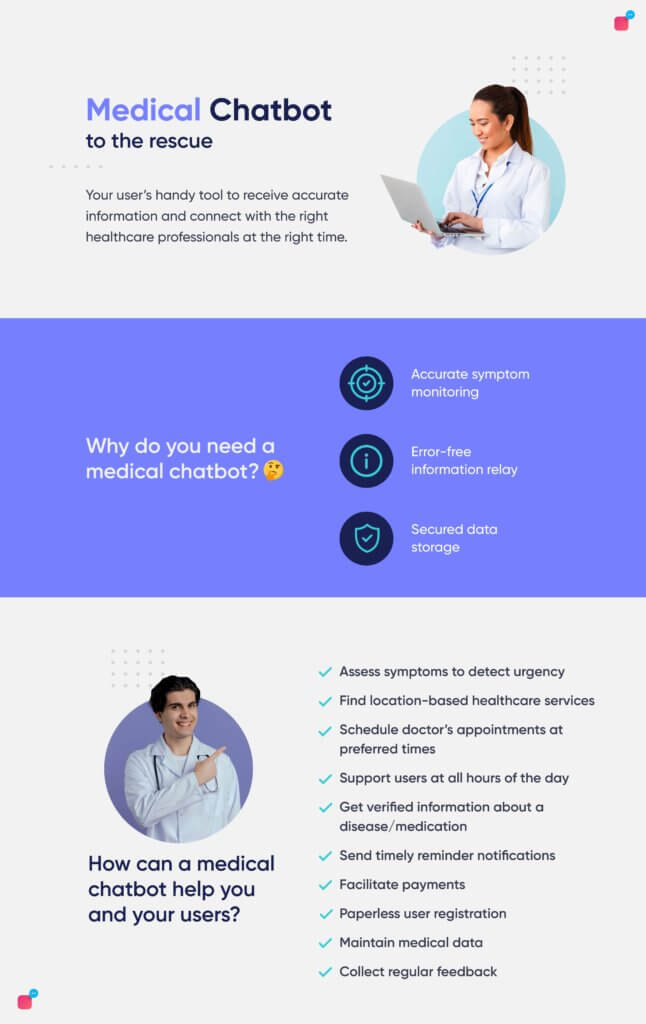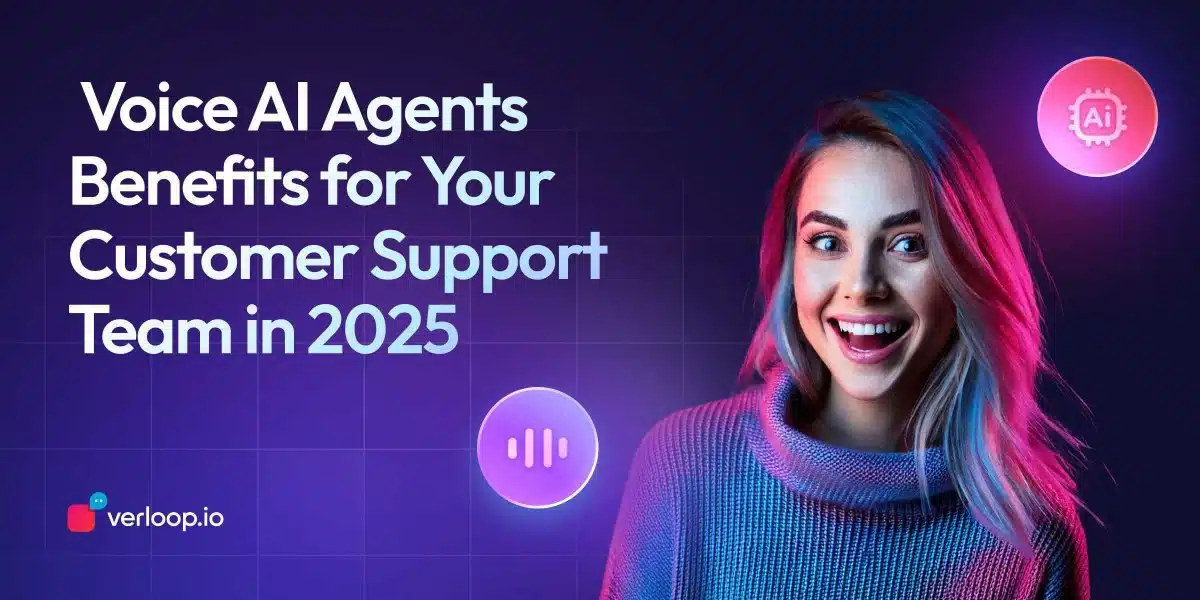Medical Chatbot: Let’s Chat-A-Bot it
- July 22nd, 2025 / 9 Mins read
-
Aarti Nair

Medical Chatbot: Let’s Chat-A-Bot it
- July 22nd, 2025 / 9 Mins read
-
Aarti Nair
We chat about the different uses of AI Agents and Chatbots. In this blog, we discuss the future of Healthcare pharma and Medical Chatbots.
Remember the days when booking a doctor’s appointment meant waiting endlessly on hold? Or when post-surgery care instructions got buried under a pile of paperwork?
Healthcare today is rapidly changing and at the heart of this transformation is AI.
From streamlining patient queries to enabling 24/7 triage, medical chatbots and healthcare AI agents (chat and voice) are becoming indispensable. According to a report by Vantage Market Research, the global healthcare chatbots market was valued at $184.60 million in 2021 and is projected to reach $431.47 million by 2028, growing at a CAGR of 15.20% from 2022 to 2028.
So, what’s driving this explosive growth?
It’s the shift towards convenience, personalisation, and cost-efficiency and all of which AI agents (chat and voice) deliver with remarkable consistency. From answering routine questions and reminding patients of prescriptions to guiding them through complex procedures with empathy, these intelligent assistants are redefining the care journey.
In this blog, we’ll explore how AI agents and medical chatbots are being deployed across the healthcare landscape and why forward-thinking providers are adopting them not just as tools, but as virtual care allies.
What are Medical Chatbots?
A medical chatbot is an AI-powered conversational solution that helps patients and healthcare companies connect with each other and provide a seamless customer experience.
Various healthcare organizations have implemented medical chatbot to eliminate workload. As the employees will be busy taking care of patients, the Medical chatbot is here to rescue. Medical chatbot helps the patient to get all the information, fix an appointment and even receive feedback.
Like most grown adults, I hate hospitals. But it isn’t just the stale food, the fact that they remind me of my impending old age, or my fear of needles and drug-resistant killer viruses that put me off. It’s something simpler than that.
Hospitals are woefully inefficient.
Take the following as an example.
While the healthcare industry is rife with tales of terror, none are as menial, but as deadly as the necktie.
I’ve always maintained that ties are the most pointless pieces of attire in clothing, serving no functional purpose besides the purely cosmetic.
I believe ties to be nothing more than decorative camouflage for my business suit; designed to shield my middle-aged male physique, with my shrinking shoulders and protruding paunch, stopping me from feeling sufficiently self-conscious to hit the gym.
But if you’re a doctor, you might share my hatred for the accessory, as the harms of wearing a tie to a hospital are much more sinister.
Neckties are Medical Nooses
In a paper titled “ Doctor’s Neckties: A Reservoir for Bacteria.” written by the American Society for Microbiology, Steven Nurkin, one of the head researchers of the study, sampled neckties worn by physicians, physician assistants and medical students at a teaching hospital in New York. As a control group for the study, they also sampled neckties worn by security personnel at the same hospital.
In the study, they found that nearly half (47.6%) of the neckties worn by clinicians were found to harbour potential disease-causing bacteria.
The odds of a clinician wearing a necktie harbouring pathogens were 8-fold greater than that of the control group.
The United Kingdom has followed suit, with health officials banning ties, along with jewellery and long sleeves from their hospitals. Officials hope the ban will slow the spread of Methicillin-resistant Staphylococcus Aureus (MRSA), a superbug that accounts for more than 40 per cent of inpatient blood infections in the U.K.
I’m sorry, but can you imagine going to a state-of-the-art hospital, complete with a spectrum of diagnostic and therapeutic technology, Tesla Digital MRI scanners, voice-modulated integrated operating theatres and a 256-slice Brilliance iCT scanner, only to be killed by the piece of silk hanging off a slightly self-conscious doctors’ neck?
So whose fault is It?
If I’m being honest though, we really entirely can’t blame doctors or nurses or hospitals for this faux pas. Working in a hospital, on any level, is unbelievably difficult.
The hours are long and painful, the work is gut-wrenching, the student bills are nothing short of preposterous, and that’s before we arrive at doctors’ mental health and fatigue.
Doctors have to come to terms with death on a daily basis, so maybe it’s not surprising that nine of 10 doctors discourage others from joining the profession, and that over 300 physicians commit suicide every year.
Imagine finally “making it” but hating what you do, whilst a quarter Mil in student loans sits in your rear-view mirror.
A lot of this strain undoubtedly comes from the absolute focus and attention to detail that being a medical professional demands.
What’s the Cost of Fatigue?
Doctors, unlike most other professions, can’t take it easy on a given day. Every single patient is unique, no matter how boring the symptoms appear on the surface.
Each result has to be stringently monitored, examined, documented and codified, increasing the administrative drain on the medical staff, hindering them from spending time and energy on otherwise more important responsibilities.
There’s been nothing that can ease this burden on doctors because there’s simply been nothing that could match their expertise or intellect.
Suggested Reading: How Chatbots Are Making Mental Health Care Accessible During Pandemic
Until now.
We all know that Artificial Intelligence is the future, even in the pharmaceutical industry.
Over the past couple of years, AI has bagged all the big headlines in the pharma-tech world.
Google launched its Google Deepmind Health project, which is used to mine the data of medical records in order to provide better and faster health services.
Watson for Oncology has an advanced ability to analyse the meaning and context of structured and unstructured data in clinical notes and reports that may be critical to selecting a treatment pathway.
GlaxoSmithKline unveiled a new $43 million project to harness modern supercomputers and machine learning systems to predict how molecules will behave and how likely they are to make a useful drug, thereby saving time and money on unnecessary tests to speed drug discovery.
While the tools for self-diagnosis have been around for years, they’ve never really caught on, the running joke being that any symptoms you enter into WebMD diagnose you with cancer.
But medical Chatbots are interactive.
Most companies engage in passive interactions with their customers, via little more than unaided website surfing. And while there have been attempts to provide information through other outlets, this mostly exasperates the problem because of a lack of synergy between applications.
Web forms are not only hideously infuriating and limiting for customers, they’re also notoriously un-interactive. The average response rate on a form is 3%, while companies report that the response rate shoots up to 20% for companies that use a medical chatbot.
Beyond increased responsiveness, a Medical Chatbot makes great fiscal sense, too.
The Challenges Facing Healthcare and Pharma Today
Healthcare and pharmaceutical organisations are under more pressure than ever and not just to deliver excellent care, but to do so at scale, on time, and with a human touch. Let’s look at some of the most common and costly challenges they face:
Poor Medication Adherence and Low Health Literacy
Most patients don’t ignore their prescriptions — they just forget, misunderstand, or never fully grasp the importance of staying consistent. Think about how easy it is to skip a dose when the instructions feel vague or you’re unsure whether to take it before or after meals. Now multiply that uncertainty across thousands of people managing diabetes, hypertension, or post-operative care. It’s not that the medicine isn’t effective — it’s that communication often ends when the patient walks out the door.
The reality? Patients need more than leaflets. They need conversational nudges, reminders in their language, and accessible explanations when they have doubts. And yet, health systems still expect people to navigate complex routines solo — while knowing most won’t pick up the phone and ask for help. That’s where real-time AI conversations can fill the gaps — guiding, reminding, and educating in ways human teams don’t have the bandwidth for.
Overwhelmed Frontline Support Teams
Hospitals and pharmacies are seeing an influx of queries that sound the same but can’t be ignored: “When is my appointment?”, “Can I cancel online?”, “What’s the copay for this visit?” These questions might seem simple, but when your staff is juggling emergency calls, inpatient rounds, and medication fulfilment — even small interruptions can pile up.
Customer support desks were never designed to carry the emotional load of healthcare. But with long call queues and increasing demand, they’re expected to provide timely, compassionate answers 24/7. The outcome? Burnt-out teams, inconsistent communication, and a poor patient experience. AI agents can intercept these high-volume, low-complexity conversations — freeing up time for human teams to show up where it matters most.
Fragmented Patient Journeys
Booking online, confirming over SMS, rescheduling on a call, and getting updates via email — that’s a typical patient experience today. And in all this switching between channels, the thread of the conversation disappears. Patients are left explaining themselves again at every step. “I already told the nurse I can’t take penicillin” or “I uploaded my report yesterday — can you check again?” These aren’t one-offs — they’re everyday friction points that hurt both efficiency and trust.
When AI agents are embedded across these touchpoints, patients don’t just get faster answers — they get continuity. A chat that starts on WhatsApp can continue on a website or phone call, and the agent already knows who’s speaking and why. That context — remembering details and carrying them forward — is what turns a frustrating journey into a seamless one.
Complex Compliance and Data Security Requirements
Healthcare isn’t just about empathy — it’s about responsibility. Misplace a file, share data with the wrong contact, or log an incorrect entry — and the stakes are much higher than an angry review. With privacy regulations like HIPAA and global equivalents tightening, every patient interaction has to be tracked, secured, and auditable.
Yet in many cases, hospitals still use outdated CRMs or paper-based systems for support queries. Can you confidently pull up a chat record from last month? Was the patient’s consent documented? Are data storage practices foolproof? This is where AI agents shine — because they can be programmed to automatically log, encrypt, and store conversations securely, ensuring that your systems remain compliant without overburdening your team.
Language Barriers and Accessibility Gaps
India alone has 22 scheduled languages and dozens of dialects. Globally, linguistic diversity is even greater. Add visual or hearing impairments to the mix, and it’s clear that one-size-fits-all support simply doesn’t work. A patient might feel confident speaking in Tamil, but not English. Another may be more comfortable listening to a message than reading a long SMS.
Most current systems don’t accommodate this nuance — they expect the patient to adjust. But healthcare should meet people where they are. AI voice and chat agents can break these barriers — offering multilingual support, voice interfaces for low-literacy users, and accessibility-first design for those who need it. And the best part? It’s scalable.
The Medical Chatbot

A stream of companies has undertaken the challenge to bridge this gap, doing everything from helping customers book appointments with doctors or operating like pseudo nurses. Below are a few companies that directly deal with the medical chatbot industry –
- Florence — this chatbot nurse tells you to take your medicine, gives you instructions if you forgot to take a pill, monitors your health (and periods for women) and can help you find specialists and book appointments in your area.
- Your. MD — it replaces the assistant of a GP, asks about symptoms and puts enough questions approved by health professionals to identify a condition probabilistically then sets up appointments, referring you to physicians.
- Babylon Health — another conversational healthcare assistant with the feature of booking a doctor.
- SimSensei — still in its experimental phase, it uses voice and face recognition to mimic a therapist, also interacting with the patient at deeper levels.
- Ada — assess the patient’s health based on their symptoms and automates FAQs. From the first greeting to the final payment, this AI-powered medical chatbot personalises content in 100+ languages and can be used across every channel.
So, while this is great news for hospitals and patients alike, it’s even better for doctors.
Take, for example, the simple task of scheduling appointments. Patients can pre-emptively provide information to the bot, that their bedside nurses or doctors will use to reduce unnecessary readmissions and organise post-discharge follow-ups.
Alerts are an intrinsic function of a Medical chatbot too. Chatbots can signal hospital staff if patients need assistance and even inform care teams of urgent changes in a patient’s status or in an emergency situation.
How AI Agents (Chat and Voice) Can Help in Healthcare
What if every patient had a personal assistant — one who never forgets a follow-up, speaks their language, works 24/7, and never gets tired? That’s not a futuristic dream. That’s what AI agents are already beginning to do — through chat and voice.
Let’s start with something simple: scheduling. Patients often delay treatment not because they don’t want help — but because booking a slot is confusing or inconvenient. A voice AI agent can guide them through available timings, confirm eligibility, and send reminders — all in under 2 minutes, with zero human involvement.
Now zoom out. Beyond booking, patients have questions:
- “Is it safe to take this medicine with food?”,
- “What are my test results?”,
- “Can I speak to a doctor again?”
These aren’t just FAQs, but they’re emotionally loaded, time-sensitive interactions. A conversational AI are trained on medical data and integrated with EHRs which can offer instant, accurate responses or smartly escalate to a human doctor when nuance is needed. No more hopping across departments or waiting hours on hold.
Voice agents go even further in regions where literacy is a barrier. Think rural clinics or elder care where typing isn’t always practical. A voice bot can walk someone through prescription instructions or post-surgery care in their native language, making healthcare feel approachable, not intimidating.
But AI agents don’t just talk. They remember. They know that Priya missed her last refill reminder, that Mr. Khan prefers evening calls, or that Ravi is due for a follow-up. That kind of context drives better care and ultimately, better outcomes. And for healthcare providers, it means fewer missed appointments, faster resolutions, and a support team that doesn’t crack under pressure.
Most importantly, these agents don’t operate in silos. Integrated with your CRM, pharmacy system, and hospital portal, they unify the experience. Whether a patient starts on WhatsApp, shifts to a website chatbot, or speaks to a voice agent on the phone, the conversation stays continuous.
Advanced AI Agent Capabilities in Healthcare
But what if your AI agent could do more than just answer common questions or help patients book appointments? What if it could actually understand the science behind healthcare, the nuance in a patient’s history, or the detail buried inside a 25-page medical report?
Especially those powered by features like AnswerFlow — truly stand out.
Imagine a patient uploads a lab report or a discharge summary. The AI agent doesn’t just acknowledge the file — it reads, understands, and responds to queries like “What was the latest cholesterol level?” or “Was any medication change advised post-discharge?” That’s the power of Document Q&A. With AnswerFlow, healthcare providers (and even patients) can upload multiple documents — PDFs, Word files, or text reports — and ask questions directly. The agent pulls out relevant insights instantly, skipping the need for manual skimming and cross-referencing.
Now let’s shift to the research side. Medical professionals often face a mountain of papers before they can recommend a treatment or publish findings. AI agents trained to support literature reviews can scan through troves of published journals, meta-analyses, and clinical trial data — surfacing summaries or highlighting contradictions between studies. This isn’t just about saving time. It’s about making evidence-based care a reality, even in time-crunched environments.
And what about internal knowledge?
Hospitals, clinics, and pharma teams often sit on a goldmine of proprietary data — from case notes to SOPs to unpublished studies. With custom Knowledge Bases, AI agents can be trained on this private corpus to answer institution-specific queries like, “What was the treatment protocol for Stage 2 diabetes here?” or “Has our facility ever encountered this rare allergy reaction?” That means faster onboarding for new doctors, better recall for experienced ones, and no more digging through folders when a patient is waiting on the line.
It all comes back to one thing: context. When your AI agent understands not just the question, but the content behind the question — whether from a document, a database, or a research archive — it stops being a bot and starts acting like an intelligent assistant.
And when you’re dealing with life-altering decisions, that level of intelligence isn’t optional — it’s essential.
Real-World Use Cases of AI Agents in Healthcare
So what does it actually look like when AI agents step into the day-to-day of healthcare and pharma teams? Let’s break it down — not into features, but into moments where the right answer, at the right time, can change everything.
Triage and First-Level Support
Think about a hospital’s helpline that gets flooded with calls every Monday morning. Patients want to know symptoms, medication schedules, or if their insurance covers a certain treatment. Instead of keeping them on hold, an AI voice agent can jump in — ask the right follow-up questions, guide them to appropriate next steps, or escalate cases that need urgent care. All without human intervention, and in multiple languages.
Appointment Scheduling and Reminders
We’ve all missed appointments because the reminder got buried under a dozen other notifications. AI chat agents not only send reminders but also reschedule appointments via WhatsApp, SMS, or voice — based on patient replies. And yes, it can integrate with hospital calendars or doctor availability in real-time.
Medication Adherence and Refill Management
Chronic care patients need regular check-ins — not just when they show up for a consultation. AI agents can send personalised reminders, check if the prescription has been followed, and even assist in reordering medication. For pharmacies, this means improved refill rates; for patients, fewer gaps in treatment.
Lab Report Interpretation and Follow-Up
A patient uploads a lab report at midnight. By morning, an AI chatbot has already analysed the document and explained what “elevated ALT” means in simple terms — along with a suggested next step: book a follow-up with a liver specialist. No panic, no Googling symptoms in the dark.
Clinical Documentation and Case History Retrieval
Doctors spend an inordinate amount of time sifting through notes or dictating follow-ups. AI agents can now retrieve previous patient interactions, summarise visit notes, and even prep documentation based on conversation inputs. That’s more time spent with the patient, and less on paperwork.
Post-Discharge Monitoring
The most dangerous time for many patients is after discharge. That’s when confusion sets in — about diets, dosages, or warning signs. AI voice or chat agents can proactively check in, ask targeted health questions (“Did your swelling reduce today?”), and flag unusual responses for nurse review. It’s like having a virtual nurse on-call, around the clock.
Insurance Eligibility and Claim Assistance
No more navigating complex IVR menus. An AI voice agent can instantly pull up eligibility, explain coverage, and walk patients through claims. For providers, this cuts down on call centre costs and increases claim accuracy.
Patient Education & Awareness Campaigns
Want to run a public health campaign about dengue symptoms or COVID boosters? AI chat agents can push multilingual, interactive explainers across WhatsApp or mobile apps — complete with image carousels, quick replies, and dynamic FAQs based on region or demographic.
And that’s just scratching the surface. The beauty of AI agents in healthcare isn’t just automation — it’s contextual care at scale. It’s the ability to deliver personalisation without personal burnout.
Suggested Reading: The Making Of The Most Comprehensive COVID-19 Bot Flow: CANbot
How to Get Started with Implementing a Medical Chatbot or Voice Agent
Implementing a medical chatbot or voice AI agent isn’t just a tech decision — it’s an operational shift. But if done right, it can improve patient satisfaction, reduce staff load, and streamline care delivery.
So where do you begin?
1. Define the Use Case, Don’t Start with the Tech
Do you want to reduce call volumes at your clinic? Automate appointment booking? Assist with post-surgery follow-ups? The use case dictates the agent design — not the other way around. Starting broad (i.e., “we want automation”) will only lead to fragmented results.
Ask yourself:
“What’s the most repetitive task our staff handles every day?”
That’s your starting point.
2. Choose the Right Platform (Voice, Chat, or Both?)
For post-discharge support or symptom triage, voice agents might be the right fit. For appointment reminders or prescription refill requests, chatbots on WhatsApp could do the trick. And in many cases, the sweet spot is a hybrid: voice for urgency, chat for convenience.
Make sure the platform you choose supports:
-
Multilingual capabilities
-
Omnichannel integrations (website, WhatsApp, IVR)
-
HIPAA or GDPR compliance
-
Custom knowledge base integrations
3. Build a Knowledge Base — Don’t Rely Only on LLMs
Generative AI is powerful, but it needs structure. Upload discharge instructions, consent forms, dosage guidelines, and common clinical protocols. Tools like AnswerFlow let you connect up to 10 documents (PDF, Word, .txt) and extract precise answers from them. This ensures the chatbot isn’t just clever — it’s clinically accurate.
Use this to:
-
Summarise patient documents
-
Train agents with real encounter notes
-
Answer FAQs based on real hospital policy
4. Create a Clear Escalation Path
Even the smartest bot knows when to back off. Ensure your system can hand over to a live nurse, customer service agent, or doctor when needed — especially for complex queries or emotionally sensitive cases.
This improves trust and keeps care human when it matters most.
5. Pilot, Learn, Iterate
Start small. Run a pilot in a specific department — like dermatology, pharmacy, or outpatient diagnostics. Monitor:
-
Drop-off rates
-
Average handling time (for voice)
-
Query resolution accuracy
-
Patient satisfaction score (CSAT)
Use the learnings to improve scripts, refine tone, or expand to more services.
6. Educate Your Internal Teams
AI agents aren’t here to replace healthcare professionals — they’re here to augment them. Run internal demos. Show how voice and chat agents reduce burnout, not patient touchpoints. Get buy-in by proving value early.
You don’t need a 6-month implementation cycle to see results. With tools like Verloop.io’s Medical AI Agents, teams are going live in under 2 weeks with fully functional, multilingual agents trained on custom documents and workflows.
What Does Medical Chatbot Mean for Us?
Medical Chatbot can also play a ground-breaking role in synergizing front office healthcare; they can streamline admissions, discharge, and transfer requests, schedule patient consultation requests and send and receive referrals.
Chatbots are programmed to facilitate collaboration between peers and update record systems with patient’s medical history, send alerts and notifications for prescription refills.
No longer will a patient turn up at a consultation only to find their notes have not been provided, chatbots will automatically send relevant training material, patient history, and pertinent data to the necessary parties ensuring the smooth running of the entire process.
And while it may seem nearly impossible to integrate information sources, chatbots can create a single system of records by transferring data from legacy systems to new databases, saving the systems time and money.
Chatbots can save thousands of working hours a year for hospitals and doctors, leading to both cost savings and a better quality of service for the user.
Want a better chance to survive your next visit to the hospital? Tell your doctor to stop wearing ties and tell your hospital to start using a medical chatbot.

FAQs: AI Chatbot Medical
1. What is a medical chatbot and how is it different from a regular chatbot?
A medical chatbot is an AI-powered tool designed specifically for the healthcare industry. Unlike generic bots, it can handle sensitive medical information, answer symptom-related queries, assist with appointment bookings, and even guide patients through post-operative care. Many platforms now offer AI agents (chat and voice) that go beyond scripted replies, understanding context and intent using generative AI.
2. Are AI agents safe for handling patient data?
Yes — provided the platform complies with data protection standards like HIPAA, GDPR, and local healthcare regulations. Many solutions allow custom knowledge base creation from private documents, ensuring that data remains secure and contextually relevant. Tools like AnswerFlow only extract answers from your uploaded documents, ensuring traceable and compliant responses.
3. What can healthcare AI agents (chat or voice) actually do?
A lot more than just booking appointments. They can:
– Triage patient queries and symptoms
– Answer insurance-related questions
– Remind patients about medications or follow-ups
– Provide guidance during chronic care journeys
– Help researchers scan medical literature
– Query and summarise internal documentation like trial data or SOPs
This reduces staff load while improving accuracy and speed.
4. How is a voice AI agent different from a chatbot in healthcare?
A voice AI agent interacts through speech — ideal for older patients, emergency support, or visually impaired users. A medical chatbot, on the other hand, operates via text and is useful for asynchronous communication like refill requests or FAQs. Many healthcare systems benefit from a hybrid setup where both channels work together for seamless coverage.
5. Can I use these AI agents on WhatsApp or my hospital website?
Yes. Leading platforms like Verloop.io allow you to deploy AI agents across WhatsApp, websites, IVRs, and even patient portals. This ensures patients can engage on the channels they’re most comfortable with — whether it’s asking questions about a prescription on WhatsApp or navigating test reports on your site.
6. What kind of content can I train my medical chatbot or AI agent on?
You can upload clinical guidelines, SOPs, discharge instructions, research papers, or any internal knowledge documents. With features like AnswerFlow, your bot can answer questions based solely on these files — ensuring factual, relevant, and accurate replies every time.
7. How long does it take to implement a medical AI chatbot or voice agent?
With the right platform, implementation can take as little as 2–3 weeks. It depends on the complexity of your workflows, number of integrations, and the quality of content you can provide for training the agent.
8. Is it possible to keep the AI agent up to date with new research or protocols?
Yes. Platforms that support custom knowledge bases allow you to update documents as needed. This means your AI agent evolves alongside your practice — ensuring it never gives outdated medical advice.







